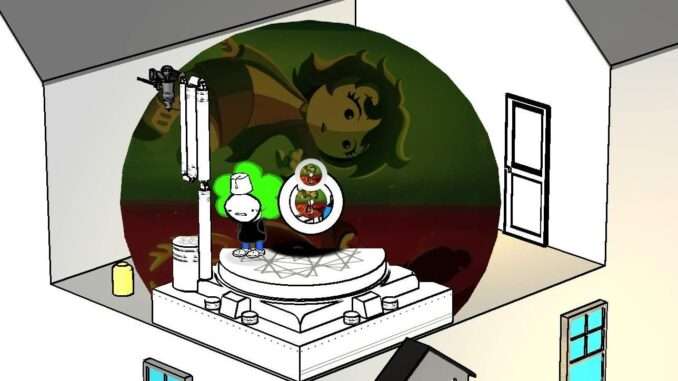
So, you’ve made the life-altering decision to bring the world to an end! This situation should be terrible for you, but fortunately, you have me! I’m here to walk you through your first steps in the game using my extensive knowledge.
Beginners Guide
So, You Managed to Open the Game!
Great job, newbie! You got this far, so you probably have a group in mind to play it with! If not, my condolences! You are destined for a Dead Session! You will physically be unable to create the necessary conditions to create a new universe.
That’s the goal of the game, in case you stumbled blindly onto this vile, cursed disk, and didn’t know what you were doing.
Moving right along!
To get all you unfortunate victims of Skaia into the same session, one of you will need to create a lobby. This is done simply by clicking the ‘start’ button.

As seen in this handy graph. This will immediately bring you to the lobby list, whereupon you can create your own house, item, or mods. We’re not bothering with those. No, we are here to play the game! Your selected lobby host will click this button.
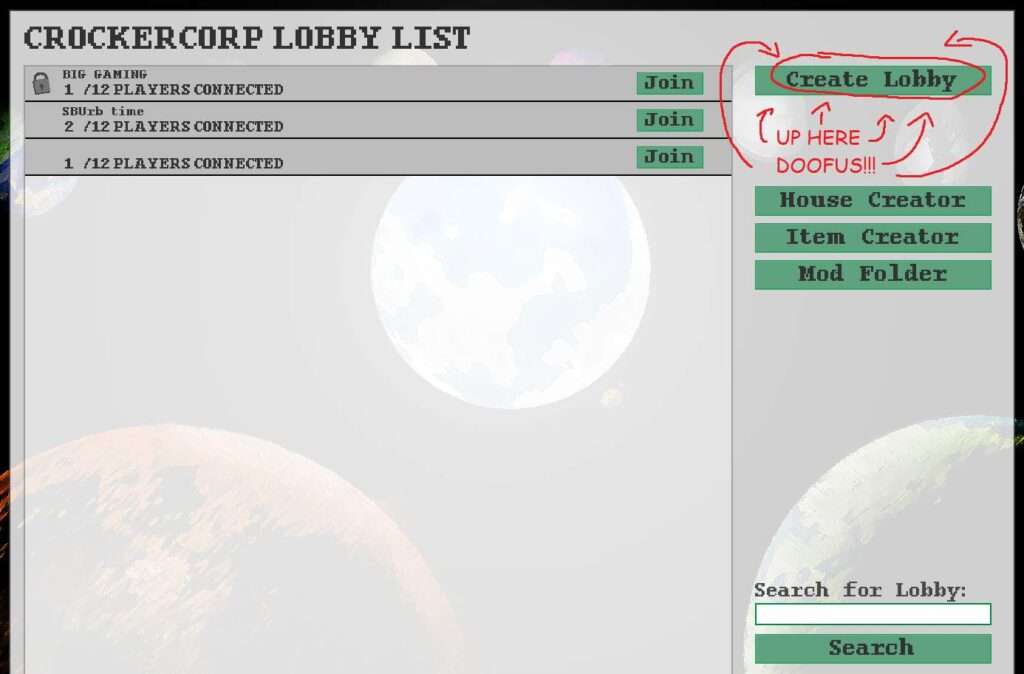
Which, in turn, will bring up this prompt:

Private lobbies will be only joinable via invite. Friends-only lobbies will be similarly, only joinable if one is Steam friends with the host. Public lobbies are openly able to be seen and searched for in the lobby list. I recommend setting a password, lest the undesirables begin to worm their way in.
We wouldn’t want that in our new universe!
Once they’re finished creating the name, password, and visibility, they simply need to press Create Lobby and it will be finished. You can join the ways listed above.
Now, for the fun part!
You Made A Lobby!
Congratulations! You’re either smart enough to figure out the lobby, smart enough to follow basic instructions, or both! These are necessary skills in universe forging.
This new screen can be scary and confusing, but don’t worry, kindred spirits, I will help you along.
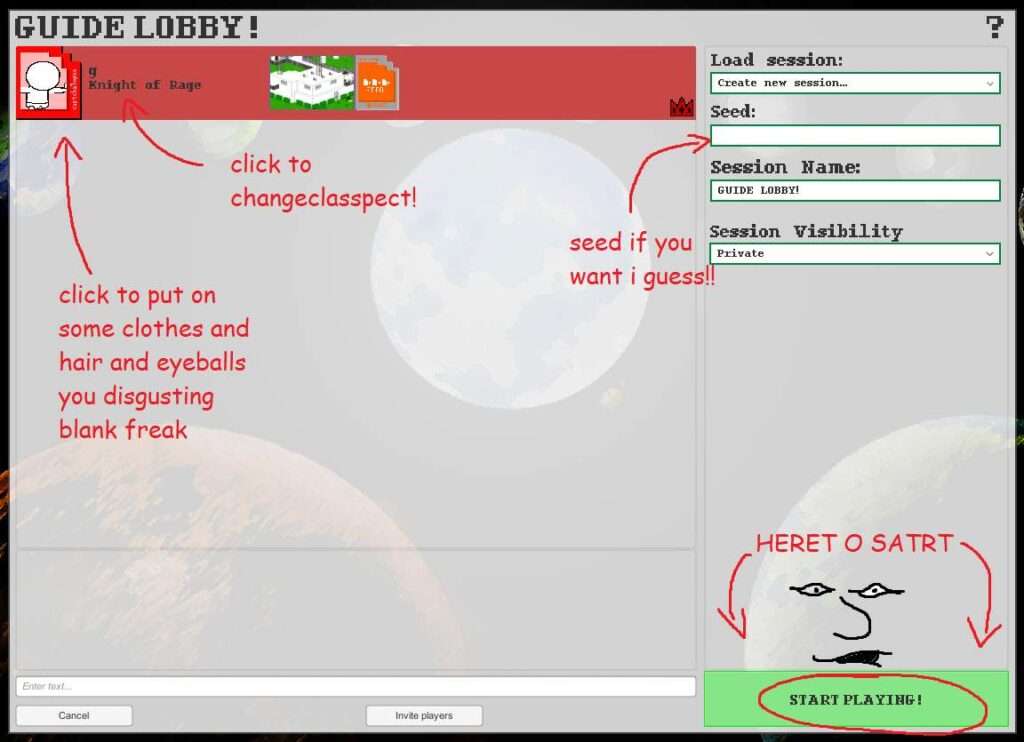
There are many buttons on this page. I have helpfully and masterfully labeled them for you.
By clicking on your default, grossly naked portrait, you will bring up the character editor! You can customize various things about your character.
Note that the color you choose will also be the color of your in-game text, sprite, and gates.

Much better!
Next, you can edit your Class and Aspect, henceforth referred to as a Classpect. There are Twelve aspects, each representing an inextricable facet of the universe. Each lords over several concepts. Some, like Time and Life are obvious, while others, like Blood and Heart, are a bit more convoluted. Lucky for you, your benevolent guide is here to wash those worries away.
Please note that in the entire history of my all-encompassing knowledge, there has never ever been a successful session without both a space player and a time player.
Aspects and You: A Cursory Glance at The Fabric of Your New Universe
Aspects can be an intimidating concept! There are twelve of them, after all, and each governs many other things, many of which in themselves are vague! Let me break it down for you, dear reader, into more digestible chunks, with the help of one of my close friends! In his own words:
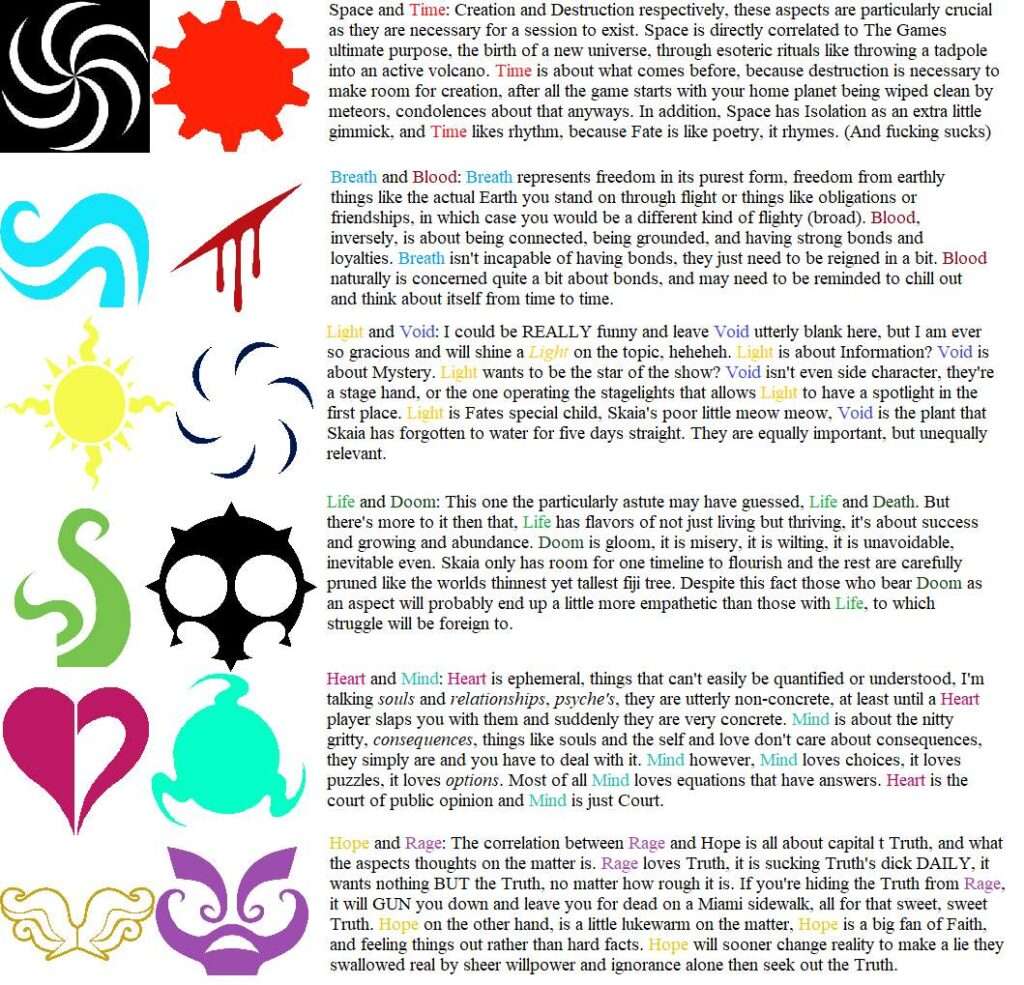
Wow! Thanks, Voidfriend!
Each of the twelve aspects, by law of nature, has an inverse. Hope and Rage, Light and Void, et cetera.
Space is the best and coolest, by the way. I am in no way biased.
Now, how does one harness these, you might ask? Well, young padawan, that is where your class comes in. Come with me.
Godhood and You: A Quick and Dirty Guide to Classes
Got all that tasty info locked in the ol’ braincase? Good! Because here’s more information, that is significantly more vague, with worse sources!
Now, as a Knight, I have experience in my field. But, to be quite honest with you all, and to keep our relationship amicable, I am going to be once again fed info from my secretive friend.
He is also telling me this is all vague ramblings whispered to him from dark corners of the universe by terrible beings unknown, but I think he’s just being edgy. Those Void players!
We won’t sweat it!
I am being told that there are, like aspects, twelve classes. Oh? Fourteen?
Okay, there are fourteen classes.
But two are stupid special cases?
Whatever. We’re going with twelve.
Take it away, Voidboy.
Class Breakdowns
Classes are like the context provided to Aspects, they’re the results to Aspects equation, the punchline to their joke. Aspects are quite literally the buildings blocks of the universe, but Classes are how you, (yes, you! The player) implement them. Now, classes are also supposed to be in pairs, but we don’t actually know concretely how they pair up except for a few because either a Void player thought they were funny or a certain someone was very lazy like a particularly rotund orange cat. They are also defined by whether they are Active or Passive, but because of the previously mentioned issue of garfieldisms we don’t know if some are active or passive. With that said let’s begin with ones that we know.
Thief and Rogue: Yes it is your favorite RPG clichés! The sneaky bastard that you need to take that rare item off the enemy that only appears in this room with a 1% random encounter rate, yes THEM! The scallywags, the rapscallions, Lupin and Robin Hood respectively. The Rogue is nice, they steal their aspect from something, that’s right, something, it doesn’t have to be an enemy, it can be the very fabric of reality itself, and they then give it to something else. That’s it, really, that’s their description, and if you know a thing or two the vaguer the description is on a power set the more busted it can be. The only limitation is that they can not steal things that are not their aspect, and they cannot give it to themselves. That is where the Thief comes in, who is in fact an Antagonist Class, which means they’ll probably be causing problems for you in some fashion, they steal their aspect and give it to themselves, only themselves, and hoard it like the greedy little buggers they are. With this knowledge you can now cheer when you get a Rogue of Breath and be on the lookout for whatever your Thief of Space is going to do.
Prince and Bard: The destructive classes, both of these classes are unhinged, utterly delusional, they turn their aspects on their heads and then curbstomp them. The Prince is the active of the pair, meaning they will actively go out and destroy their aspect and destroy using their aspect. Additionally the Prince is devoid of their aspect as well, so if you have a Prince of say, Life, pat him on the back because he’s probably having it rough as a zombie who can’t escape poverty. The Bard is more…subtle in their destruction, they’re a little slothful and would much rather let someone else destroy their aspect for them. Their keyword is invite, as in they invite the destruction of their aspect by others. This is what makes them passive, and a bit of a wildcard as well. Both of these destructive classes are Antagonists as well, so be wary of their ♥♥♥.
Heir: We don’t know exactly, but we have a pretty good damned idea that they inheirit their aspect, it just sort of comes to them, partially through work and partially through plot contrivance. We do know that they’re passive, which does tell support the idea that they sit there and get handed their aspect at a convenient time like little Timothy being passed down great-great-great-great grandpappies old reliable tome of unspeakable horrors that are proof that they don’t make them like they used to.
Knight: Their passive or active status? Unknown. Their impressive finery? Known and acknowledged. Knights are an interesting one, in that they make up for the lack of their aspect in the session, protecting it like a chivalrous noble protecting his fair maiden atop the finest gilded pony in the land. If your session has a Knight, rejoice! For certain aspects they’re very beneficial and are known to work quite hard, but dismay, for your session needed them in the first place. Knights also have a bit of a gimmick with putting up a false façade like self-conscious teenagers, so you can have fun chipping away at that with teasing comments or tearing your hair out at their inability to be sincere. An additional note, it is not known if Knights are required for a healthy session or if they need to help with making the genesis frog, stop saying they are/do, you Neanderthals.
Witch: An active class, they are ones who manipulate their aspect, bending the unspoken rules of their aspect, how and why can they do this, magic, that’s how. Mind presents two outcomes, or an ultimate choice? The witch will take both, thanks. Doom says something is inevitable, that Death comes to all? Maybe take a rain check deary, come back to the session with that later. Undoubtedly these are very strong abilities, but the nature of sburb is that a classpect won’t be fully realized instantly. A Witch of Time may find ♥♥♥ mixtapes on the internet and remix them into sounding good before the game, and be ignoring causality like it’s the final episodes of a season of Doctor Who by the end of the session.
Seer: The best class, because without it you wouldn’t be reading this to even know why its the best class, so pay a little respect. A passive class, Seers are gifted with inherent knowledge, their foresight, as represented by their affinity for pondering their orbs like wizards wise beyond their years, will be a boon to their session. Seers are tasked with dutifully carrying the burden of keeping their super-powered universe making friends from making terrible decisions like the ill prepared gremlins that they are. Seers know their aspect like the back of their hands, as well as an affinity for the inner workings of Sburb itself, which means they’ll probably be the ones reading this review and trying to convey its vital information to their fellow players, in which case I see you, and good luck getting them to listen. For you non-Seers reading, thank your local Seer.
Maid: A great deal is unknown about Maids, but in my professional opinion they most likely serve their aspect, as befitting of their title they dutifully keep their aspect nice, tidy, and in order for the session and Skaia. What is known about Maids is their powers, boasting the ability to apply powerful single target buffs/debuffs on a target, a Maid of Hope for example could embolden an ally with unwavering confidence and willpower, or have an enemy spiral into doubt. A Maid can be found flitting around the session seemingly guided by an invisible hand, setting the stage for important events and keeping things on track, a Maid of Doom might show up on your planet, kill a plot relevant NPC, softlocking your session and ensuring your timeline is thrown into the cold abyss, all so that another session will succeed. Ouch, not a pleasant scenario, but that’s Doom for you, at the very least they’re probably very nice to talk to.
Sylph: The good doctor is in, Sylphs heal their aspect or heal using their aspect, for a Sylph of Life this can simply be green plusses appearing above you until you’re good as new or more unorthodox medicines. A Sylph of Rage may force you to take some bitter pills of truth for your own good, a daily dose if you will, while a Sylph of Hope would lift your spirits with re-assurances. A Sylph looks after their aspect with all the warmth of a mother hen, and if you damage it you’ll quickly be reminded that chickens are lizard brained killing machines without an ounce of mercy.
Mage: Perhaps the class with the least confirmed about it, Mages are most likely related to knowledge of an aspect in some form or fashion much like the Seer, but less cool, befitting of my station and for convenience I will be extrapolating here but acting like its accepted fact. Mages are those who suffer from their aspect, and from their suffering others may learn from them. The great prophets, scorched by the words of god, or less reverently the guy who proceeds the installing of warning signs, he who did not watch his step, he who asked for the Wet Floor cone, Skaia will seem to have it out for them and provide them wisdom at a price, this may make them bitter but its your responsibility to do something with his failure and actually walk around the wet floor.
Page: So, you know how I said Mages were Skaia’s sufferers? The unlucky few that are assigned Page by the incomprehensible intelligence of Fate are cursed with potential. The Gohan kind of potential. The “you’ll be so cool later I promise” kind of potential. Pages are, similar to Maids, in that they probably have something to do with serving their aspect, or alternatively creating it. They are touted as the most powerful fully realized class, though it is a long and treacherous road to get to that point. Besides their power and the effort to get it, the defining feature of a Page is being held back, something, or someone, is your dedicated tormentor. Skaia in its infinite wisdom has decreed that your potential has been hindered and locked away by a malevolent and oppressive influence that leaves you, well, to be honest, and you either should or are going to hear this eventually anyways, kind of pathetic. But if you follow the path of a Page with patience and virtue (probably) you will (probably) cast off your chains and become a so called “badass”. Note: I have never seen this actually happen, but it would be nice I think, so good luck.
Muse and Lord: Pray to all the many tentacled ancient ones of the furthest ring that you never, EVER encounter either of these. If you do, I highly suggest finding the nearest way out of your session and never looking back until you find help.
Wow That Was A Whole Lot Let’s Take A Breather

Much better.
Jesus, dude. Seers are so weird.
Houses and Sylladexes and SBURB, Oh My!
Think you’re done with all this metagamey BS?
Wrong!
Silly reader, you still haven’t selected your House or Sylladex modus.
Here is yet another brilliant diagram on how to do such a thing.

There are only a handful of houses to choose from, and any of your saved custom houses will show up here as well.
Note
As of writing this guide, the Boondollar Mansion does not have a SBURB disc in it anywhere. This will result in a rather horrible softlock, and your friend who wanted to live in a mansion will be killed by angry meteors. Don’t pick it yet.
The funny little colored card next to houses is your Sylladex modus.
If, somehow, you don’t know what a Sylladex is, think of it like a video game inventory mixed with code functions. It’s contrived, I know. Sylladexes have a limited amount of open cards, but more can be found.
The selectable fetch modii are as follows.
Queue: Queue is, well, a queue. Items you pick up will queue up like orderly patrons getting on the thrill ride that is the inside of your extradimensional pockets. The first in line will be the only one you can access without spraying everything in front of it out of your inventory like a hose. Exceeding the limit of inventory space will rocket the first available item out of your Sylladex like a projectile weapon, so be aware of that.
Learned that the hard way.
Stack: Stack is, once again, self explanatory. You’re piling all the items you hoard in your pocket dimension like a slob. Anything new gets placed on top, and when you reach in, you can pull out whatever is on top. Very simple. Not very effective.
Array: Array is the nerd’s choice. It’s like a neat little filing cabinet. You can put in whatever, and pull it out however you want. it may be hugely lame and boring, but it sure is efficient.
Hash Map: Oh yeah, now here’s the coolkid’s modus. Hash Maps are like Arrays, except not dumb and boring. They work like an Array, except storing items uses a value structure. If two items would occupy the same value, the old one is ejected and the new one is stored. Otherwise, you can access any of them like you would in an Array.
Tree: I honestly have no idea why you’d pick tree. I guess it looks cool? Either way, tree works like… A weird tree. There’s a Root card, which is the first thing you get your grubby hands on. Make it something useless, because if you take the root out, literally everything else will fall out of your Sylladex. The root supports two branches, which can either support two more branches or two leaves. Cards are only leaves when they do not have anything attached to them, otherwise they become a branch.
Keeping up? Good! That’s it for all these dumb, stupid, boring menus. Time to hop into the game! Make sure you’re all ready and kiss all your loved ones goodbye, because it’s time to initiate the apocalypse via meteors.
Getting Into the Game: What to Do and How to Do It
So, you’ve made your peace with your loved ones and God, and your decision to decimate the entire planet. Great! Click that ‘start playing’ button to initiate the ability to initiate global apocalypse!

You’re in! Look at that devilishly handsome/dangerously cute little rascal. They need a name!

Perfect!
Now, you’re in! Let’s break down the UI (User Interface, for those uninitiated) for you.
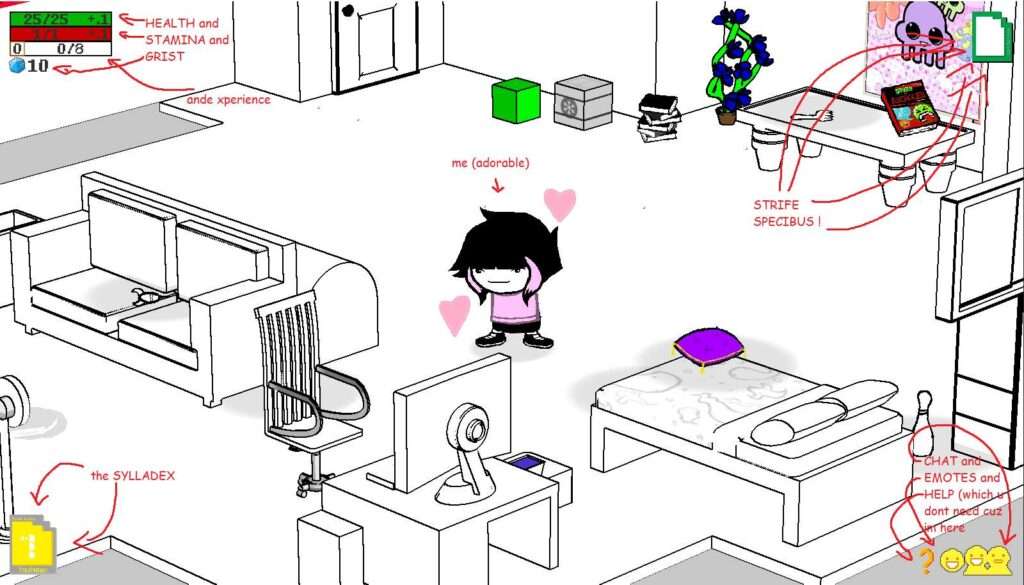
In the top left, you will find your health, stamina, experience and grist.
Health is as expected. Lose it all and you’re dead. Dead dead. You’ll take damage when you get hit and you’ll take damage when you fall from too high. You can get it back by eating and drinking, or other healing abilities. Hope you got a Sylph!
Stamina gets used when you do anything special, which is anything tied to action buttons that aren’t walking, jumping or left clicking. Right now, only ABJURE and ABSCOND will use it. It slowly regenerates over time.
Experience is gained by killing underlings, which we’ll get to later. For now, don’t worry about it.
Grist is similarly gained by killing underlings, as well as your host using the Bulldozer building tool. You use Grist for building and for alchemy. There’s an insane amount of types, which you can look at by clicking the little Grist gusher. You start with 10 Build Grist automatically.
Important Note
Grist is not as tasty as it looks. Trust me.
Moving on!
In the top right is your strife portfolio. If you’ve never done a strife before, well, you have no idea what you’re in for! I’ll explain it anyway because I am a very benevolent and kind guide. You can place items from the environment or your Sylladex into it, and now you’re able to use them as weapons! Items fall into categories, when we’re dealing with the Strife Specibus. My personal choice is Bladekind, because ♥♥♥ it’s so cool.
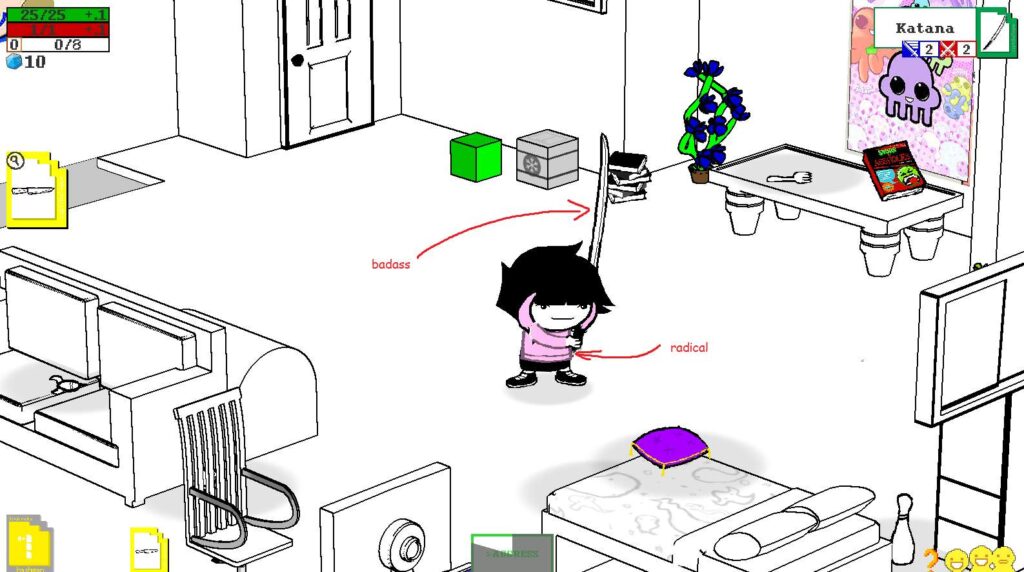
Swing that ♥♥♥, girl.
My friends like Bowkind, Prongedkind, Otherkind, and Clubkind. There are probably more. You can only have four Specibi, so be careful what you shove in there.
In the bottom right, you have your chat, emotes, and the official tutorial guide. We don’t need that last one.
The chat is just a chat. You can talk with your equally ill-fated friends! The emotes let you do faces. Or go to bed.
Finally, in the bottom left, you have your Sylladex, which we’ve gone over previously. Clicking the actual fetch modus will bring up a menu with a few buttons.

The big giant Eject button will shoot everything out of your pockets at terminal velocity. It’ll also let you pick which modus you want again.
I have literally no idea what the ‘detect collisions’ checkbox does. Maybe you’re better at experimenting than I am, but I can’t figure it out. Good luck!
The draw simple box will let you see your ‘dex on the bottom of your screen, and the draw detailed box will let you see it bigger on the left.
The auto-pickup box will attempt to nab anything you walk over or next to. This is useful for things you can’t see or click, but be careful because it also has the ability to eject things over capacity.
Now that all that’s finally out of the way, let’s get cracking!
You’re Ready! What Now?
So, you’ve trudged through all that exposition, and you’re FINALLY ready to move into the game! Right?
Wrong!
You have to get the game first. If you follow GameGrl, or GameBro, I guess, you’ll know this ♥♥♥ is some physical computing. Ancient. As such, it’s on a disc. This mythical ‘disc’ is somewhere in your house. If you picked John’s house, whoever that is, the disc’ll be in the kitchen, behind a potted plant. If you picked the Interlude house, it will be in the vile clutches of your Guardian. They’ll be located on the other side of the house, on a balcony. You’ll have to engage in some strife to get the disc. They’ll drop it at around 1/3rd of their health, along with a fun little note, so don’t kill them, you murderous animal.
The balcony will most likely block the disc and note from being able to pick them up. Luckily, there’s a handy dandy little checkbox we looked at earlier that will automatically pick up items!
So, you’ve got the disc. You should also have a poke around your house. Familiarize yourself with it, grab some items, and equip a weapon. Once you’re finished, head up back to your room, and more importantly, your PC that is for some reason equipped with a disc drive.
Slap that sucker into the computer and then interact with your monitor to get building!
Can We Build It? Yes We Can!
A whole new interface, with all new buttons to explain! Joyous day, I get to make another diagram!

This one’s also pretty complex, so let’s work through it together. I know, I know, you cannot wait to read even more of my super cool and awesome guide.
Close closes the build menu. Escape also works. The save and load buttons don’t do anything when you’re connected to your client player.
Oh, yeah. You’re looking at one of your friends’ houses, assigned to you by the will of Skaia (gross, I know). Hope you’re a good architect!
Undo and Redo undo and redo your last action, respectively. Or they should, anyway. They’re annoying and sometimes don’t work.
You can control the camera with those arrow buttons, but R and T and up and down on the arrow keys will do the same thing a little easier.
Select will select objects. Easy! Left click again to put it down again, or Delete to recycle them. Recycling will give you build grist.You use build grist for just about everything that creates, because creating things from nothing is for Space players.
Next is the Revise button! You build walls with this. They need to be attached to a floor, and the walls will surround the floor. There’s no real way to build or delete just walls, so be careful with it. There’s a little button underneath it when you click revise that will allow you to place floor by itself, which is a bit more intuitive.

Deploy will bring up a big menu of many, many objects. Most of them you probably won’t need to put down, but keep in mind they’re there. The stairs and doors are all in here, so remember those most of all, you’re gonna need them when you accidentally delete your friends’ or move them or something.
Bulldoze will let you delete floors. Simple enough, right? Kinda! It gets pretty jank with walls. Just fiddle with it until you get the hang of it.
So, next, and extremely importantly: The Phernalia Registry. Each of these items is entirely vital to getting into the actual gameworld, the Medium, without dying. Past that, they’re used for Alchemy, which is really good and cool and magic. More on that later.
Next, your build grist. Very simple! Placing or building anything at all EXCEPT things in the Phernalia Registry will consume it. Each floor tile consumes one, and deploying things will have the cost next to them in the menu.
The Atheneum would contain items to put down, but you can’t do that if you’re not making a custom house, so don’t worry about it.
Get it? Got it? Good. This next bit is life and death. Literally! Let’s go!
Into the Unknown: I am Going to Make it Known For You So You Don’t Die
So, we’re going to get into the Medium, here. This is serious. Get serious’d up.
Create an area for your friend to do their mad scientist stuff. Make sure it’s spacious, flat, and with little clutter, because it’s very easy to mess up and drop something in the heat of passionate meteor dodging.
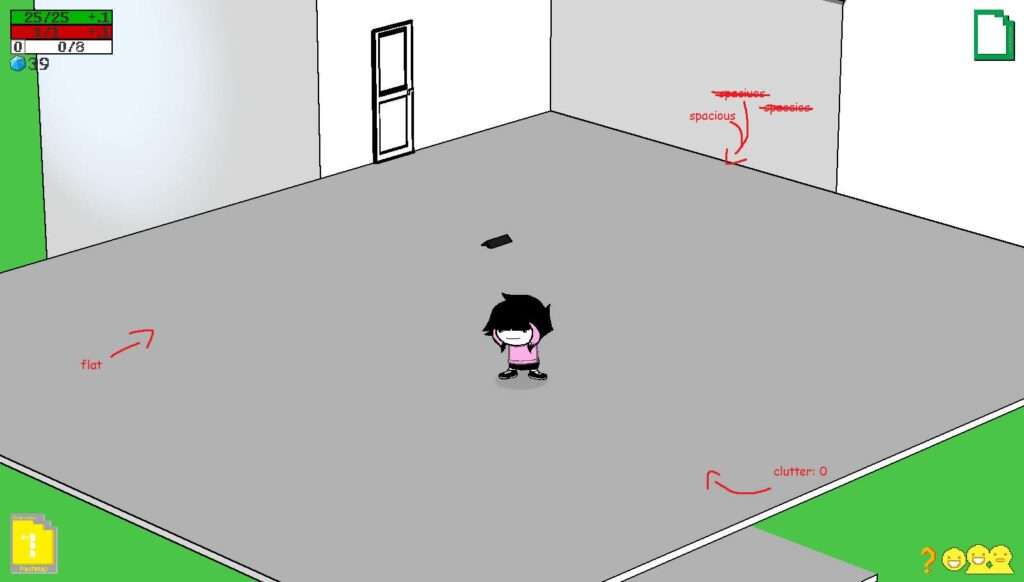
Like this!
Okay. Now, put down your Totem Lathe, Alchemiter, Punch Designix, and the prepunched card. They are all labeled in the Phernalia Registry.
Do not put down the Cruxtruder yet, to prevent any unfortunate accidents.
Bring up whatever item that you would like to speak to for an extended period of time. I’ll explain later. This includes Squiddles, Knights, Harlequins, Bunnies, a Problem Sleuth poster. There may be more but I haven’t seen them.
I will now explain the process you have to go through to get into the medium. It’s very simple, but commit it to memory to minimize confusion, ’cause if you ♥♥♥ up, you die!
When the Cruxtruder is opened, this will start a timer. That timer is how long you have until a real big meteor smacks that exact location dead in the face. If you’re not in the medium, this will be your house and also you and you will die.

My cool kernelsprite and impending death.
When you open the Cruxtruder, you will be able to receive Cruxite Dowels. These are very important. Also very important is the spazzy little floating guy that will come out of it when you open it. The host or the server player, but likely the host, because the server player will be busy not dying, will drag the item that you wouldn’t mind speaking to into the Kernelsprite. This will prototype that object.
It is imperative that each sprite is prototyped.

My cool sprite.
Now that that’s out of the way, grab that Cruxite Dowel and the Prepunched Card that was placed and stick both of those into their respective spots on the totem lathe. The machine will lathe the unrefined dowel into a Totem, which we need to use to alchemize your entry item.
Take the lathed totem and stick that into your alchemiter to create said entry item. Once it’s done, use it, and voilà! You’re in the medium and have traded imminent death for imminent danger!
Imminent Danger and How to Avoid Said Danger
Okay. You, and hopefully all of your friends, are in the Medium. Awesome! Good job! Pat yourselves on the back for about a half second because you will immediately be under attack.
SBURB is a game, and games typically have enemies. Your enemies, for now, are the underlings. You’ll be dealing with imps, mostly, until you get levels and then gremlins and even ogres will start spawning. Imps are nasty, rude little grossboys. Kill them, because they drop both Grist and Experience.

You may notice that your chosen weapon sucks pretty bad. That’s normal! To solve this, whatever shred of benevolence Skaia has or ever had gave us the joys of Alchemy. Let’s break it down.
It all starts at the Punch Designix. You can use this to make punchcards of items. Layering two of them will combine them, and using two single-punched cards in the alchemiter will also combine them, albeit differently. I’ll be using || and && respectively to talk about them further.
Note
Punching a card in the designix gets rid of it!

Here, I’ve just punched a card to be used for an && alchemizing.

I’ve also punched a gushers card and grabbed a cruxite dowel. Putting all of these in their slots at the totem lathe and pressing the && button will carve the dowel with your combination item’s code!

Now, bring it to your Alchemiter to realize your Frankenstein’s Monster.

Well, if you have enough of the correct grist. This one wants Build Grist and Uranium Grist, which I do not have. Go figure! You get the idea.
|| alchemy works in much the same way, but instead of putting both cards in the lathe, you put them both in the designix and put the result in the lathe. It’s the same from there. I recommend doing a bunch of alchemy because it is both fun, and how you upgrade your gear.
I’m In, I’m Dripped Out, What Now?
A great question! Well, dear readers, you’re almost to the end of my wondrous guide. Just a few more explanations and well-made charts and you’ll be ready to get going on your new universe.
By this point, I’ll assume you’ve killed enough underlings to have enough experience to level up! Leveling up grants you useful stats and skills, all of which you can find in the ABILITIES section of the pause menu. To level, just click the little flashing number on your Experience bar, under your stamina.
When you’re leveled, imp-free, and done with your alchemy binge, you may have noticed that a new button has appeared in the bottom right.

This is your handy dandy map. It will show you all the planets in you current session, each of which belongs to a player. Your space player’s will always have frogs on it. They are extremely important. We’ll get there later.
Clicking on any one will show a bunch of funny circles, a rough map of the area, and a little symbol corresponding to a player.

Here’s me in the Land of Frost and Frogs!
Those funny circles you see are gates. They’re the objective of the game! Going through all 8 gates is your main objective while you’re on your planet. The first one is always located right above your house! So, get building! Once you pass through, you’ll be on your planet proper. You’re on your own from there.
In Conclusion
I’m off to take a nap. Frog breeding and making a guide and being a supercool Goddess of Space really takes a lot out of you! You have this handled from here. Good job so far, and good luck on creating a new universe! Goodbye, for now!


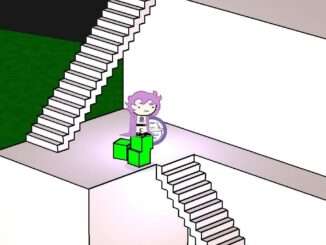
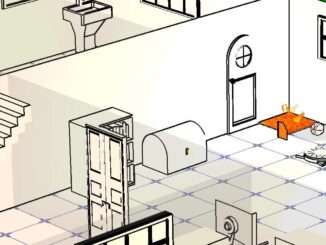
i would like to add that atheneum can stores dowels for ease of access in a session and are not as useless as you think!